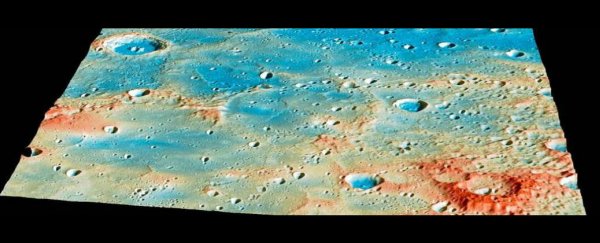In an expected - albeit violent - end to its 11-year mission, NASA's MESSENGER spacecraft collided with the rocky surface of Mercury this week at speeds of just over 14,000 km/h, leaving behind an entire crater in the process.
"Going out with a bang as it impacts the surface of Mercury, we are celebrating MESSENGER as more than a successful mission," one of the team, John Grunsfeld, from NASA's Science Mission Directorate in the US, told the press. "The MESSENGER mission will continue to provide scientists with a bonanza of new results as we begin the next phase of this mission - analysing the exciting data already in the archives, and unravelling the mysteries of Mercury."
Unfortunately, because MESSENGER ended up landing on the side of Mercury that faces away from Earth, our ground-based telescopes weren't able to record the dramatic impact. Mission control confirmed the crash-landing when they could no longer get a signal from the intrepid spacecraft.
According to NASA, MESSENGER's last day of real-time flight operations began at 11:15 am EDT, marking the end of a mission which saw it orbit Mercury an impressive 4,105 times. During this time, it managed to collect data on Mercury's surface composition and its geological history, and helped scientists make the discoveries that the planet's internal magnetic field is offset from its centre, and that its polar deposits are mostly filled with water ice.
"We monitored MESSENGER's beacon signal for about 20 additional minutes," mission operations manager, Andy Calloway, said. "It was strange to think during that time MESSENGER had already impacted, but we could not confirm it immediately due to the vast distance across space between Mercury and Earth."
First launched on 3 August 2004, MESSENGER made it to Mercury on 17 March 2011 and has been spinning orbits around it ever since. It finished its primary mission back in 2012 - which was to gather images and data on the planet from above - but because it was doing such a good job up there, NASA has extended its mission twice since then.
"During a final extension of the mission in March, referred to as XM2, the team began a hover campaign that allowed the spacecraft to operate within a narrow band of altitudes from five to 35 kilometres from the planet's surface," NASA explains. Knowing that MESSENGER was at the end of its life, NASA got a little bit more reckless with the spacecraft and made it perform seven "daring" orbit correction manoeuvres to collect information on features such as Mercury's crustal magnetic anomalies and icy polar craters.
"Today we bid a fond farewell to one of the most resilient and accomplished spacecraft to ever explore our neighbouring planets," Sean Solomon, MESSENGER's principal investigator and director of Columbia University's Lamont-Doherty Earth Observatory in the US, said in the press release. "A resourceful and committed team of engineers, mission operators, scientists, and managers can be extremely proud that the MESSENGER mission has surpassed all expectations and delivered a stunningly long list of discoveries that have changed our views - not only of one of Earth's sibling planets, but of the entire inner Solar System."
RIP, little spacecraft. You did good.
